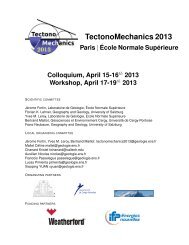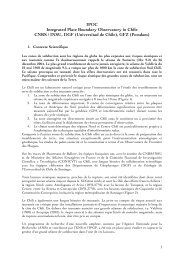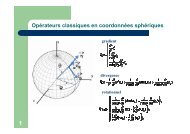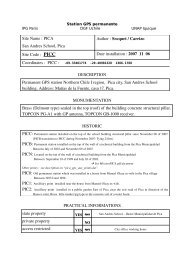PDF file - Laboratoire de Géologie de l'Ecole normale supérieure - Ens
PDF file - Laboratoire de Géologie de l'Ecole normale supérieure - Ens
PDF file - Laboratoire de Géologie de l'Ecole normale supérieure - Ens
You also want an ePaper? Increase the reach of your titles
YUMPU automatically turns print PDFs into web optimized ePapers that Google loves.
4<br />
SOCQUET ET AL.: GPS MEASUREMENTS TO REFINE INDIA/SUNDA RELATIVE MOTION<br />
permanent Malaysian network acquisitions from 1999 to<br />
2001, the Asia Pacific Regional Geo<strong>de</strong>tic Project<br />
campaigns from 1997 to 2000 [Govind, et al., 1999], the<br />
first or<strong>de</strong>r Thai network measurements in 1994-1996-<br />
2000 and data from Hy<strong>de</strong>rabad GPS station in India<br />
from 1996 to 2000 ⎯ as well as already published data<br />
⎯ GEODYSSEA data [Chamot-Rooke and Le Pichon,<br />
1999; Michel, et al., 2001; Simons, et al., 1999], GPS<br />
campaigns in Sulawesi from 1999 to 2002 [Simons, et<br />
al., 2000; Vigny, et al., 2002; Walpersdorf, et al., 1998;<br />
Walpersdorf, et al., 1998], Myanmar campaigns in 1998<br />
and 2000 [Vigny, et al., 2003], West Nepal network<br />
measurements in 1991-1995-1997-1998-2000 [Bilham,<br />
et al., 1997; Jouanne, et al., 1999; Larson, et al., 1999],<br />
the Kathmandu transect campaigns from 1998 to 2000<br />
[Avouac, et al., 2001; Jouanne, et al., 2004] and data<br />
from 30 IGS stations world wi<strong>de</strong> spread (Fig. 1). The<br />
raw GPS measurements were analyzed in 24-hours daily<br />
solutions with GAMIT [King, 1999].Velocities were<br />
estimated and mapped in ITRF-2000 [Altamimi, et al.,<br />
2002] using GLOBK/GLORG softwares [Herring,<br />
1999]. A slightly different data set (80% common<br />
stations in SE Asia) was also processed in<strong>de</strong>pen<strong>de</strong>ntly<br />
with GIPSY OASIS II software [Blewitt et al., 1988]<br />
and published separately [Simons et al., submitted]. We<br />
combined these data with ours, again using GLOBK.<br />
The GAMIT processing, the combinations, the reference<br />
frame mapping and the error analysis are <strong>de</strong>tailed in the<br />
electronic supplement. Fig. 1 <strong>de</strong>picts the velocity field<br />
we obtain with respect to the Sunda Plate.<br />
4. India / Sunda motion<br />
4.1. India <strong>de</strong>formation and motion<br />
From a geo<strong>de</strong>tic point of view, the Indian plate<br />
remains un<strong>de</strong>formed up to the foothills of the Himalaya.<br />
Actually, and contrary to what one would expect from<br />
simple elastic coupling theories, stations in southern<br />
Nepal hardly show any motion with respect to India.<br />
Baselines lengths between points located in Southern<br />
Nepal (MAHE, NEPA, BHAI and SIMR) and points<br />
located further south in continental India (HYDE and<br />
IISC) vary by less than 2 mm/yr (Table 1, Fig.2). Since<br />
the residuals do not show any systematic trend, we<br />
conclu<strong>de</strong> that these small numbers are representative of<br />
the data uncertainties rather than the actual rate of<br />
<strong>de</strong>formation. [Jouanne, et al., 2004; Larson, et al.,<br />
1999; Paul, et al., 2001] found similar results since their<br />
south Nepalese points move at less than 2 mm/yr with<br />
respect to IISC. We thus consi<strong>de</strong>r in the following that<br />
velocities of South Nepal stations are in<strong>de</strong>ed<br />
representative of the motion of the Indian plate. A new<br />
geo<strong>de</strong>tic rotation pole for the India Plate in ITRF-2000<br />
was thus <strong>de</strong>termined using two Indian stations (IISC and<br />
HYDE) and four southern Nepalese stations (MAHE,<br />
NEPA, BHAI, SIMR) located south of the Main Frontal<br />
Thrust. The Maldives station was not used because we<br />
processed only two sets of measurements separated by<br />
a year interval only, explaining its poor velocity<br />
<strong>de</strong>termination. In any case, Maldives Island is located<br />
into the diffuse zone of <strong>de</strong>formation between India and<br />
Australia. In ITRF-2000, our pole <strong>de</strong>termination for<br />
the Indian Plate is 50.9°N, -12.1°E, 0.486 ± 0.01 °/Myr<br />
(Table 2). The computed error ellipse was constructed<br />
from variance-covariance matrix <strong>de</strong>scribing<br />
uncertainties, linearly propagated from the errors<br />
assigned to the data, following the method <strong>de</strong>scribed<br />
by [DeMets et al., 1994]. Its semi-major axis is<br />
oriented N108° and is 5.11° long and its semi-minor<br />
axis is 0.61° long. The shape of the ellipse (ratio<br />
between long and short axes and ellipse orientation) is<br />
mainly constrained by the geographical distribution of<br />
the stations. Here, the longitudinal uncertainty is larger<br />
because there is a tra<strong>de</strong>-off between the angular speed<br />
and the distance pole / plate. Residual velocities for the<br />
stations used for the pole <strong>de</strong>termination are below 2<br />
mm/yr with an rms of 1.29 mm/yr (Figure 2). In or<strong>de</strong>r<br />
to compare our pole with previous studies, we rotate<br />
our India/ITRF-2000 pole with respect to the Eurasian<br />
Plate <strong>de</strong>fined by [Calais, et al., 2003]. With respect to<br />
Figure 2: GPS velocities in India, Nepal and Western<br />
Myanmar with respect to the Indian Plate. Error<br />
ellipses show the 95% confi<strong>de</strong>nce level. Black arrows<br />
belong to Indian plate. The main tectonic structures are<br />
also represented on the GTOPO-30 sha<strong>de</strong>d topography.<br />
MCB: Myanmar Central Basins. Inset: Vector<br />
components of the residual velocities used for the India<br />
/ ITRF-2000 pole <strong>de</strong>termination. Units are in mm/yr.<br />
Indian stations display residual velocities below 2<br />
mm/yr (circle).






